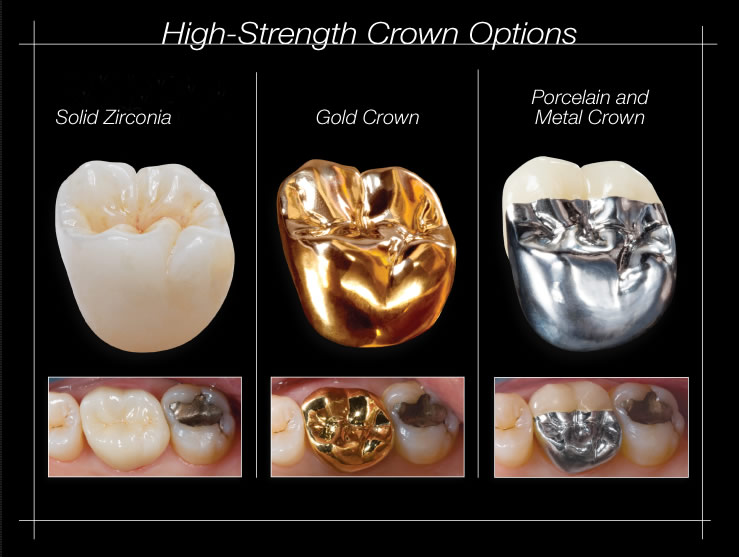
Cost: Dental crowns can be expensive, particularly if you opt for higher-quality materials like
porcelain or ceramic.
Sensitivity: Some patients may experience tooth sensitivity after getting a dental crown. This is
especially common in the days following the placement of the crown and may require the use of
desensitizing toothpaste or other treatments.
Decay: If the tooth underneath the crown becomes decayed or damaged, it may need to be
removed entirely, which can lead to additional dental work or even tooth loss.
Discomfort: In some cases, the placement of a dental crown may cause discomfort or pain,
particularly if the crown is placed too close to the tooth’s nerve.
Potential for damage: Crowns can potentially break or crack, particularly if they are made from
materials like porcelain or ceramic. This can require additional dental work or even replacement of the
entire crown.
1. Porcelain-Fused-to-Metal (PFM) Crowns: These crowns consist of a metal base with a porcelain or ceramic coating fused to the outside. They are a popular choice due to their durability and natural appearance. PFM crowns can be used for both front and back teeth and are a good option if you want a strong and natural-looking crown.
2. Zirconia Crowns: These crowns are made entirely of zirconia, a strong and durable material that can withstand the forces of chewing. They are a good choice for back teeth that require extra strength and durability. Zirconia crowns are also tooth-colored, so they look natural in the mouth.
3. Full Zirconia Crowns: These crowns are made entirely of zirconia, similar to zirconia crowns. However, they have a higher translucency, allowing them to reflect light more naturally, which can make them a better choice for front teeth. Full zirconia crowns are also very strong and long-lasting.
4. Emax Crowns: These crowns are made of a special type of ceramic called lithium disilicate, which is known for its strength and natural appearance. Emax crowns are ideal for front teeth because they are translucent and reflect light in a way that is similar to natural teeth. They are also durable and long-lasting.
Typically, the minimum tooth structure required for a crown to be successful is the length of the remaining tooth from the gum line. This is called ferrule in dental terms and for a crown to be possible more than 3 mm length is required.
What is better than dental crowns?
Some alternative options to dental crowns include:
Dental Veneers: Veneers are thin shells that are placed over the front of the teeth to improve their appearance. They can be used to correct a variety of cosmetic issues, such as discoloration, chipping, and uneven spacing.
Dental Bonding: Bonding involves applying a tooth-colored resin material to the surface of the tooth and then shaping and polishing it to match the surrounding teeth. It is a quick and minimally invasive way to repair chips, cracks, and other minor cosmetic issues.
Dental Implants: Implants are a more permanent solution for missing teeth. They involve surgically placing a titanium post into the jawbone and attaching a replacement tooth on top.
Inlays and Onlays: Inlays and onlays are custom-made restorations that are used to repair larger areas of decay or damage. They are made of porcelain or composite resin and are bonded to the tooth to restore its shape and function.
Ultimately, the best treatment option for you will depend on your specific dental needs and goals. Your dentist can help you determine the most appropriate option for your situation.
High-quality materials: Dental crowns are typically made of high-quality materials such as porcelain, ceramic, or zirconia. These materials are durable, long-lasting, and designed to mimic the appearance of natural teeth.
Custom fabrication: Each dental crown is custom-fabricated to fit the specific shape, size, and color of the patient’s teeth. This requires skilled technicians and advanced technology, both of which come at a cost.
Advanced equipment: The process of creating a dental crown often involves the use of advanced equipment such as computer-aided design (CAD) software and milling machines. These machines are expensive to purchase and maintain, which can drive up the cost of dental crowns.
Time and labor: The process of creating a dental crown can be time-consuming and labor-intensive. It typically involves multiple appointments and requires the skill of a trained dentist or dental technician.
Today, the terms “cap” and “crown” are used more or less interchangeably and both refer to the same type of restoration. Dental crowns/caps can be made from a variety of materials such as porcelain, ceramic, zirconia, metal alloys, or a combination of materials, depending on the specific needs of the patient and the judgment of the dentist.
as a general guide, the cost of a dental crown in Albania can range from approximately 8,000 to 20,000 Albanian Lekë (ALL), which is equivalent to approximately 75 to 190 US dollars (USD). It’s important to note that this is only a rough estimate and that the actual cost can vary depending on.
Best Dentist in TIrana: All dental brands available at affordable prices. Getting your smile makeover without breaking the bank.